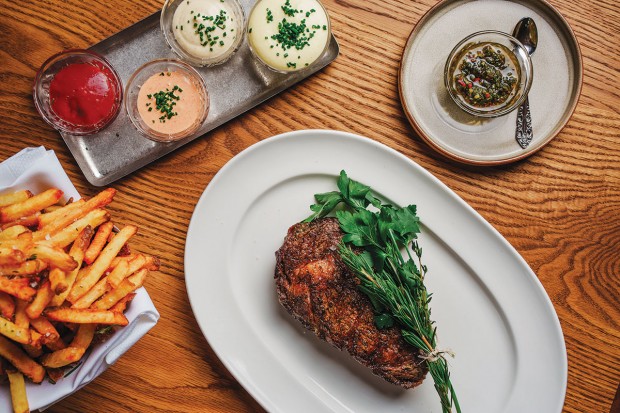The Goode Son: Charting his course


IN GOODE SPIRITS Chef-owner Levi Goode oversees the family-owned Goode Co. group, originally started by his father, Jim. Now he has introduced two new concepts, independent of the Goode Co. brand: Credence, a restaurant that honors his Texas roots and live-fire cooking, and Sidebar, a modern 50-seat speakeasy. Levi collaborated with award-winning whiskey producer Milam & Greene in Blanco, TX, to make his namesake single-barrel bourbon featured in The Improved Old-Fashioned serve at Sidecar. (Photo: Jody Horton)
Levi Goode leans on his father’s lessons as he strives to create his own restaurant legacy.
“My father was super creative,” said the West University resident. “He used to say, ‘Be bold. Life is too short.’”
His father, Jim Goode, was a Houston food legend. He didn’t just create a brand – Goode Co. – the former graphic artist started a legacy in 1977 when he put down his ink pen for barbecue tongs. On a whim, he invested every cent into a failing red barn barbecue joint on Kirby Drive owned by a recent widow ready to pack her things and return home to East Texas. Before the ink dried, the lady threw Jim the keys and said, “It’s yours.”
Levi was barely out of diapers then, just three years old. But the $6,000 gamble paid off handsomely. Within a decade of opening, Goode Co. Barbecue served 800-1,000 customers daily. The Lone Star State cookery icon passed on Feb. 2, 2016, but left an indelible impression.
“One of the first places I had barbecue was Goode Co. I remember being blown away,” said San Francisco native Robert Del Grande, Houston’s first James Beard Award-winning chef. “It captured everything I thought barbecue should be – the stacks of mesquite wood, the hand-rubbed brisket, the tables outside. It was this Texas thing where you know where you are by what you’re eating.”

VERY GOODE “It’s my family signature style – cooking over coals and open fire. It’s not just my family; it’s Texas and cowboys cooking on the trail. It’s all rooted in live-fire cooking," Levi said. Pictured: Whole ducks roasted over a live fire fueled with mesquite and post oak wood. (Photo: Brian Kennedy)
Today, the Goode Co. name is nationally recognized, and its Brazos Bottom Pecan Pie is shipped worldwide. CEO Levi oversees the family-owned Goode Co. group, which operates 11 restaurants. Its six concepts are packed with loyal diners, many of whom know the menus by heart. Levi, twice nominated for the prestigious James Beard Award for Outstanding Restaurateur, could have stopped here and focused on the tasks at hand. But Jim Goode’s only son is a chip off the old block. His father also taught him to “Keep it fresh and exciting.” So, Levi, age 49, has tempted fate by launching his most ambitious project.
In August, he introduced two new concepts – his own – independent of the Goode Co. brand: Credence, a soaring, high-ceiling restaurant, and Sidebar, a modern 50-seat speakeasy. Both are located within The McKinley at Memorial City (9757 Katy Freeway), a resort-style luxury apartment high-rise across from Hotel ZaZa and Ciro’s Italian.
“We’ve been working on this for quite some time, years actually. It’s good to finally be in this place and share it with the public. We’ve pulled out all the stops,” said the fifth-generation Texan.
He began with a clean slate. The name was carefully chosen to start. He picked the name “Credence” to reflect belief and truth. “There are no truer stories than our own. Nothing is more authentic than something personal,” he said about the restaurant that honors his Texas roots and live-fire cooking. The name “Sidebar” is self-explanatory. “We had a lot of fun with that one. We wanted to do something along the way of the 1930s regarding the design, inspired by Texas oil wildcatters the likes of McCarthy and Cullen types, who might have visited and enjoyed similar places after striking oil in their backyard.”
Sidebar smells of new leather from the chocolate brown leather panels covering the walls. Above the snug reservation-only room, a shower of silver beads, carefully hand-strung to form chandeliers reminiscent of fringed Gatsbyesque flapper dresses, illuminates the room. It is a transitional space for slow, unwinding, and deep conversations.
Sidebar customers are given a code to access a door in the back of the building off the parking lot or through Credence. Open Thursday, Friday, and Saturday evenings only, it has a cover charge for live music, Champagne service, and an extensive handcrafted cocktail menu. Levi said the table size might be small, but the bites are “decadent. I’ve got Beef Tartare Sliders – butter-toasted brioche squares topped with caviar. There is a tasty hot oyster dish, Oysters Balinese, with creamed leeks, crispy bacon, and béarnaise sauce.”
Goode Co. restaurants are rooted in family recipes, starting with Levi’s father, Jim, and his uncle, Joe Dixie, waking up hourly to check on the brisket at Goode Co. Barbecue (5109 Kirby Drive). In 1981, Levi’s paternal grandmother, Emma “Nanny” Longoria Goode, inspired the mesquite-grilled fajitas and Mexican breakfasts at Goode Co. Hamburgers and Taqueria (4902 Kirby Drive). The company’s famous pie? That’s hers. Years spent fishing and crabbing along Texas and Louisiana lured his outdoorsman of a black-bearded father into opening Goode Co. Seafood (2621 Westpark Drive) in 1986. So, Goode Co. doesn’t have an official title “chef” for its restaurants.
Here, Levi is the chef-owner at Credence and Sidebar. He collaborates with talented Joseph Geiskopf on the elevated Texas ranch-inspired menus. Chef Joseph previously worked at CIEL (4411 San Felipe), and several Michelin-starred restaurants, including Pineapple & Pearls in Washington, D.C. Credence’s dishes are drawn from Levi’s travels, experiences, and memories. As you scan the offerings, it seems Levi has chosen his favorite hits for his new independent concept. One outstanding is the Parisa, a raw dish, and “a riff on beef tartare from the Alsatian pioneers. I would always eat it whenever I was in Medina County,” Levi said. “For ours, we use lightly cold-smoked beef tenderloin.”
Another standout is the Deviled Crabs with tomato butter served on the half shell. They are filled with ample sweet jumbo crab and infused with a smoky flavor from a mesquite wood oven. “Last night, a guy ordered two more after tasting those,” a waiter commented.
Guests can watch a flurry of kitchen activities from the dining room, including roasting whole ducks, dry-aged steaks, seafood, carrots, and cabbage over an open fire. “It’s my family signature style – cooking over coals and open fire. It’s not just my family; it’s Texas and cowboys cooking on the trail. It’s all rooted in live-fire cooking. I grew up with that,” Levi said. “There was just something special about cooking over mesquite and oak. Maybe it was being around the campfire, but I always felt it made the food taste its best. So, I built a 12-foot-wide hearth – essentially a big fireplace – that we’re cooking out of at Credence.”
On a recent Sunday, typically a slow night for most restaurants, Credence was fully booked. Couples and friends were sipping updated versions of Palomas and Negronis in the adjoining lounge while waiting for their tables. While savoring complimentary madeleines with paper-thin slices of hickory-smoked Benton ham in the main dining room, a few guests inspected the soaring double barrel-vaulted ceiling and arches. Architecture and design firm Gensler incorporated luxurious elements, such as antique rugs, brass fixtures, and rich, wood finishes. The design balances masculinity and femininity using greens, golds, and whites. Additionally, unique artworks and pieces collected by Levi from his travels, such as an 1870s rack adorned with cleavers, are featured in the space.
“I started from the bottom up,” Levi said. “I was 10 years old, washing dishes at the taqueria. I stood on a milk crate to reach over the sink and wash those dishes. I’ve done every job in the restaurant. You have to do that to learn the business. I borrow on experience.”
He’s unsure if his three children will follow in his footsteps. His son, Mason, might. “We’ll see,” he said. He does know this: “The business is dynamic. We have to keep our ears to the ground and stay true to our roots. Evolution has also been a part of my upbringing, which is why we have a variety of concepts. My father started with barbecue and then went on to taqueria, then seafood. He liked to try new things. He taught me to do the same.”

PARISA Levi Goode’s Parisa is “a riff on beef tartare from the Alsatian pioneers,” he said. To elevate the flavor, he uses lightly cold-smoked beef tenderloin. (Photo: Brian Kennedy)
There are many versions of this raw delicacy. Levi likes to cold-smoke his beef, which adds another irresistible layer of flavor. This step is optional, so you can skip it if you’re lazy.
For garlic-shallot oil: 4-5 garlic cloves, peeled
3-4 shallots, peeled and cut in half
2 sprigs rosemary
5-6 sprigs thyme
2 cups olive oil
For cold-smoked beef:
8 ounces beef tenderloin, butterflied
2 ounces wood chips
For Parisa: (2-inch) thick jalapeños, halved, seeded and minced fine
2 tablespoons shallots, peeled and minced fine
1 ½ teaspoons capers, drained and minced
1 teaspoon serrano chile, roasted, peeled and seeded
2 ¼ teaspoon Creole mustard
1 teaspoon lime zest, grated with a microplane
1 ½ teaspoon sherry vinegar
1 teaspoon kosher salt
½ teaspoon ground black pepper
3 tablespoons Aged White Cheddar Cheese, grated on a box grater, divided
For garnish:
1 tablespoon chives or green onions, sliced thin
1 tablespoon fried crispy red onions or shallots (see note)
5-7 ounces of potato chips (waffle or ridged)
To make garlic-shallot oil, place garlic, shallots, rosemary, thyme, and olive oil in a small saucepan and place over low heat on the stove. Stir occasionally as the oil comes to a simmer. Once the oil simmers, allow the garlic cloves and shallots to cook for 20-30 minutes (or until flavors are infused into the oil). Strain and allow the oil to cool before using. Oil can be made a day in advance before use. Store at room temperature in an air-tight container.
Levi has devised a simple way for the home cook to cold-smoke the beef tenderloin. If you don’t have a smoker, place two ounces of wood chips in water and allow them to soak for 15 minutes. Drain the chips and place them on aluminum foil. Fold the foil sides up to create a “cup.” Place the cup on one side of a large food-safe container, such as a rectangular Pyrex baking dish. Position the beef tenderloin on the opposite side of the baking dish.
Light the wood chips and allow them to smoke for 1-2 minutes. Cover with foil and smoke the meat for 10-15 minutes. Remember: We want to add smoke flavor but not cook the meat. Once smoked, remove beef tenderloin and refrigerate for 30 minutes to make it easier to cut.
Prepare the Parisa in a mixing bowl by adding the smoked beef tenderloin, along with one and a half tablespoons of the garlic-shallot oil, jalapeños, fresh shallots, capers, serrano chile, Creole mustard, lime zest, sherry vinegar, kosher salt, black pepper, and two tablespoons of cheddar cheese. Mix ingredients very gently until they are well combined. Cover with plastic wrap and place in the refrigerator for five minutes or until thoroughly chilled. Store remaining garlic-shallot oil for another use, such as vinaigrette and stir-fries or to make more Parisa.
Transfer Parisa to a small bowl and garnish with one tablespoon of cheddar cheese, chives or green onions, and crispy red onions or shallots. Serve with waffle or ridged potato chips. Serves 4.
Note: You can find fried shallots and onions at the grocery stores. But if you want to make your own, it’s easy. Peel and slice thin eight shallots. Bring about 11⁄4 cup of vegetable oil in a frying pan to temperature over medium-low heat. Add shallots and stir them often with a fork to encourage rings to separate until shallots are golden brown, about 20-25 minutes. Pour shallots into a strainer to drain and transfer to paper towels, and then season with kosher salt (optional). Fried shallots will keep in an airtight container at room temperature for a week.
Want more buzz like this? Sign up for our Morning Buzz emails.
To leave a comment, please log in or create an account with The Buzz Magazines, Disqus, Facebook, or Twitter. Or you may post as a guest.



